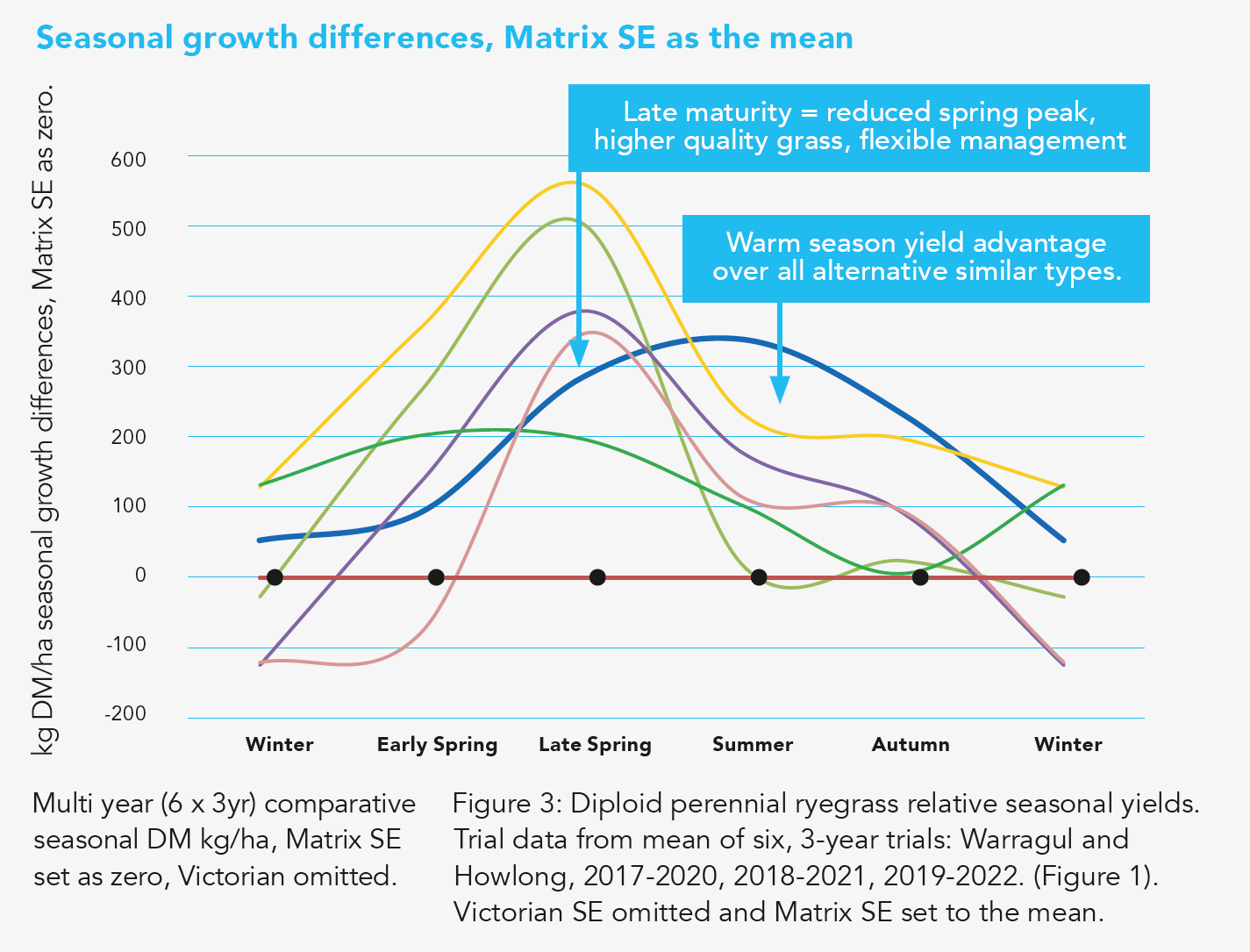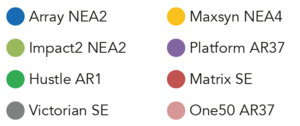Download the Array NEA2 tech sheet
Array NEA2 Perennial Ryegrass
Lolium perenne
pH 4.8 – 8.0, min rain 700mm, most soil types
Array NEA2 diploid perennial ryegrass takes your high-performance pastures into summer and through the most testing part of the year for ryegrass pastures.
Array was selected from other leading candidate trial lines for all-year-round growth and particularly for late spring and summer yield and quality.
With Maxsyn providing outstanding overall yield and cool-season performance, Array will offer an opportunity to compliment grazing systems with flexibility for feed timing and the highest summer yield potential.
Where to use Array NEA2
- Highest feed availability in late-season perennial ryegrass pastures.
- Dairy, beef cattle and sheep.
- Grazing quality pastures through summer.
- High quality silage production.
- Temperate higher rainfall zone (>700mm) or irrigation.
- Standout new variety to replace Impact 2 and compliment Maxsyn.
Benefits of sowing Array NEA2
- A new benchmark for warm season perennial ryegrass
performance. - 8% yield improvement over Matrix SE in 18 years’ worth of trial data. (six trials of three years each)
- Very late heading (+23 days): retains feed quality longer into spring and early summer.
- Reduced spring peak for flexible management.
- Better late spring quality and summer growth than earlier heading types.
- Densely tillered and upright growth habit: high harvestability and legume compatibility.
- NEA2 endophyte:
- Excellent black beetle, Argentine stem weevil tolerance and good root aphid tolerance.
- No concern for ryegrass staggers or reduced animal productivity.
- Proven endophyte in Bealey, Impact 2, Kidman and Rohan perennial ryegrasses.
Performance: Dry-matter yield

“Array has shown brilliant performance in the warm seasons, and exceptional persistence for such a high quality and late season variety, which makes it a real winner. We’re also excited to see farmers realise the benefits of Array’s upright growth nature as it seems to readily allow that bit more room for companion clovers. This variety will be well received by operations looking to maintain feed quality through the spring flush and more feed when the going gets tougher through summer and early autumn.”
Rob Winter, Agronomic Services Manager.
Seasonal Growth - Array NEA2 advantage



By taking the data from figure 1 and applying to a series of seasonal growth curves we can start to see the relative merits of the cultivars in a season utility sense (figure 2). Victorian SE is well out-classed, and there are some interesting variations in the timing of performance of the other trial entries.
To demonstrate the relative difference in utility, we can develop greater resolution by setting Matrix SE as the mean. (Figure 3). This then reveals where Array NEA2 is quite different from most other varieties: late spring and summer.
Persistence

On-farm persistence trials have indicated that Array NEA2 is in the leading cohort for plant survival over three years. The combination of yield, out-of-season performance together with retaining plant numbers over time, means that you can count on Array NEA2 to persist through grazing, silage, hay and general farm operations as well as offering quality feed and good all-year round yield.

Management and Agronomy
Array perennial ryegrass is suited to temperate higher rainfall or irrigated locations with optimal growth between 10-30°C. Good paddock preparation will aid establishment. Use methods such as stale-seed bed, or a targeted herbicide program to reduce the weed-seed burden in the paddock, especially grass weeds. Application of slug bait may be an important consideration. Array is best sown with soil temperatures of at least 10-12°C in early-mid autumn or in early spring as establishment below 8°C may be slower. Companion grasses should be sown at rates that compliment the performance of Array. Blended with tetraploid perennial ryegrass such as 4front NEA2, Array will offer a denser sward and improved resilience to tougher seasons. Combined with a diploid perennial ryegrass such as Maxsyn NEA4 to spread the seasonal growth a little earlier, or with Rohan NEA2 to offer increased tolerance to wet sites and close grazing, Array is a flexible inclusion for many pasture solutions. Clovers should be sown at robust rates that provide opportunity for satisfactory pasture composition. Grazing management that seeks to avoid selective grazing will enhance and retain good pasture composition.
Sowing rates:
Sole grass, drilled: 17.5-25 kg/ha
Over-sowing: 10-15 kg/ha
In grass mixes: 7.5-10 kg/ha
Sowing depth:
10 - 15 mm
Array will require well-maintained pasture fertility levels to offer full productivity benefits. Array and companion species will need maintenance of phosphorus, potassium, sulphur and other elements provided to ensure continued performance and persistence. Initial and regular soil testing is recommended. Once established, Array pastures should be rotationally grazed to from 2½-3 leaf stage to optimise feed quality. Graze down to 3-5 cm residuals within 2-3 days and remove stock to allow rapid recovery and yield maximisation. Array with NEA2 endophyte has beneficial effects on black beetle, root aphids, and Argentine stem weevils.
Typical co-species
Other pasture grasses
Diploid perennial ryegrasses: Maxsyn NEA4, Rohan NEA2
Tetraploid perennial ryegrasses: 4front NEA2
Clovers and forage herbs
White clover, red clover, sub clover, plantain.
Seed Presentation
Treatment: Available as bare, untreated seed. Treatment available on request
Pack size: 25kg net weight.
As a ready-to-sow mix
Renovator 850 (Rohan NEA2, Array NEA2, Storm & Weka white clovers): 25-30kg/ha
Renovator HR (4Front NEA2, Array NEA2, Storm & Weka white clovers): 25-30kg/ha
Additional Links
Perennial Extensive Pasture Guide



